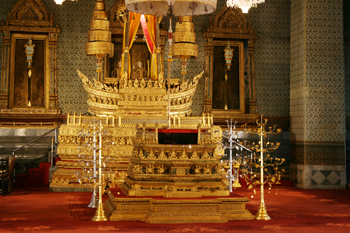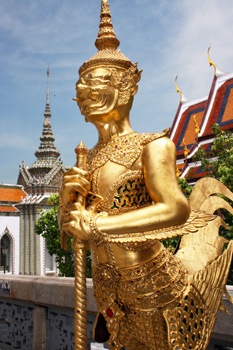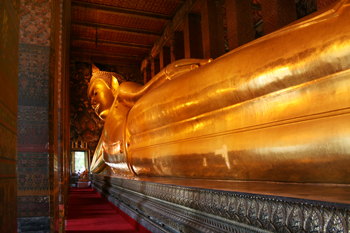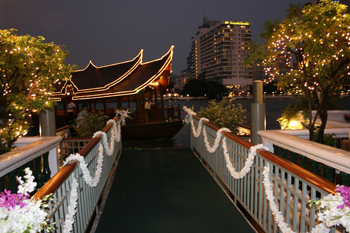“Madame, where you go? Grand Palace open. Wat Pho closed. Open this afternoon. Holiday this morning.”
We must have heard this two dozen times on our walk between the Grand Palace and Wat Pho. This is perhaps the most famous of the scams of Bangkok, Thailand. Men and women stand on the sidewalks surrounding the Wats (temples), telling people that the sites are closed for a holiday and will reopen in the afternoon, when they will be able to see a special ceremony performed by the monks. They then suggest that the tourist spend the intervening time visiting alternate sites, such as the Wat of the Black Buddha, and offer to arrange for a tuk-tuk driver to take them around for some ridiculously small fee (like a dollar for half a day). Many tourists fall for this ploy, only to find themselves being driven around to shopping centers (interspersed with a temple or two) for hours, where they are subject to high pressure tactics of shopkeepers trying to foist poor quality gems, silks and carpets on the victims. The scam operators and tuk-tuk drivers are paid by the shopkeepers for every tourist they deliver. By the time the tourist figures it out, they are back at Wat Pho, usually laden with packages. Fortunately, I know about this scam (I fell for it three years ago myself), so Joan and I avoided the detour this time, just laughing and brushing off the multitude of scam artists that accosted us.
I have delayed visiting any of the Wats or temples in Bangkok on this trip because I have seen most of them before. I wanted to wait until my friend, Joan, arrived so we could share the experience together. We headed for the Grand Palace early this morning in an attempt to tour the site before the heat and humidity of midday descended upon us.
The Grand Palace was constructed in 1782 AD by King Rama I after the establishment of the city of Bangkok. It covers more than a square mile and houses the royal residence and throne hall (see below), as well as a number of government offices. Included among the many temples at the site are the renowned Royal Monastery of the Emerald Buddha, one of the most venerated sites in Thailand where people convene to pay respect to Lord Buddha and His teachings. The Emerald Buddha is enshrined on a golden traditional Thai-style throne made of gilded-carved wood, known as a Busabok, in the ordination hall of the Royal monastery. The sacred image is clad with one of three seasonal costumes (summer, rainy season, and winter). The costumes are changed three times a year in a ceremony presided over by His Majesty the King.

The Emerald Buddha is in fact carved from a block of green jade and was first discovered in 1434 in a stupa in Chiang Rai in northern Thailand. At that time the image was covered with plaster and was thought to be an ordinary Buddha statue. Later, the abbot who found the image noticed that the plaster on the nose of the image had flaked off, revealing the green stone underneath. The abbot believed the stone to be emerald, thus the legend was born. Sadly, no photos are allowed of the Emerald Buddha, so I cannot show it to you.
Also found at the Grand Palace are three buildings named the Phra Monthian Group, the most famous among them being the Audience Hall, which is used for a number of State ceremonies such as the one commemorating the birthday of the King. The hall’s main feature is a throne that is surmounted by a nine-tiered white canopy, flanked by two seven-tiered white umbrellas, and backed by a boat-shaped altar. There were no photos allowed in this room either but it was not as well-guarded as the Emerald Buddha, so I was able to snap a quick shot.


The Phra Siratana Chedi, commonly referred to as the Golden Mount, is a huge golden stupa with a towering spire. Surrounding it are dozens of chedi statues, monkey-like mythical beings that adorn the temple and act as protectors, along with the giant statues of chedis that stand guard on either side of every entrance to the temples. I am fascinated by these chedis, by their monkey-like character, by the fierce expressions on their faces, and by their regal bearing.

After the Grand Palace we head for Wat Chetuphon (shortened by everyone to Wat Pho), which is most famous for its giant reclining golden Buddha. By now it is midday and, exhausted by the heat, we seek refuge at the Oriental Hotel, one of the most famous of Bangkok’s five star hotels. In its air conditioned Verandah Restaurant we enjoy a $45 lunch of fruit smoothies (green tea yogurt for me and pineapple mint for Joan) cream pumpkin soup and crab salad with papaya for Joan, and a vegetarian platter of vegetable protein and tofu with mixed vegetables over rice for me. Absolutely delicious – and thoroughly enjoyed in ice cold air conditioning.


Unwilling to return to the mean streets of Bangkok just yet, we hop on the hotel’s private boat that takes across the Chao Phrya River to the Mandarin Oriental Spa. We are given a short tour of the site, with its traditional Thai Restaurant, its famous cooking school, and its two spas – one for traditional Thai massage and the other an Ayurvedic Spa, featuring treatments from India. Unable to resist, we opt for the Yogayam Treatment, combined with a floral bath. I was led to a room with wood floors, walls and ceilings, where I disrobed and climbed into a plush terry robe. Wicker roll down blinds covered the windows, allowing only dappled sunlight to reach inside the room, giving everything a soft, golden glow. After a foot wash, I climbed into a big copper tub filled with fresh jasmine and rose petals and soaked away the grime of the city for 20 minutes. Heavenly! This was followed by 90 minutes of a therapist manipulating my various body parts into Yogic poses and then stretching me. Now, that’s my idea of exercise – let someone move me around and do it for me! We cross back over the river at sunset, the boat and hotel grounds stupendous in its miniature white lights and orchid garlands.
So, I again pose the question – Will the real Bangkok please stand up? The truth is that Bangkok is both things. It is streets filled with scam artists and the decadent pleasures of five star hotels. It would not be Bangkok were it not so and I love it all the more for it.

I have heard of this scam before. I have enjoyed reading your posts about Bangkok, as I am heading to Thailand for the first time in a couple weeks. I wasn’t planning to spend much time in Bangkok, but the more I learn, the more I want to see.
Hi City Ga;: I love Bangkok and encourage you to spend at least a few days there!
The tuk-tuk rip-off reminds me of a time in bangkok when a driver cam eup to me and told me the fee for half a day is only this if you allow me to take you a special shop and you appear interested in what they have. The they pay for my fuel. If you do this I will take you to the places that you want to go. His honesty was disarming and I went along and he was good to his word. I kept my end of the bargain at a jewellery shop and we both were very happy and he got a decent tip too.
Hi Mark: I got caught in the same scam and my tuk tuk driver was pretty up
front about it too. No real harm done, although I did have to endure a bit
of high pressure sales tactics in the shops, and I actually saw a couple of
sights I never would have seen otherwise.
Excellent job.
I’ll opt for the decadent pleasures of the Oriental Spa and leave Khao San Road to you! It’s simply delicious and I love that place. I’ll be there in October. I’ve always said one either loves Bangkok or one hates it. The choice is up to you. I love it.
Thanks for taking the time to share all these pleasures and travails.
I see Macendonia photos on the list. If you are going there, let me know. I’ve got some ramblings to share from my recent visit there.
We were plane mates with you coming from Seim Reap. Your account of the things you see is very good and interesting. I have given your site to many of my Florida friends and they have had very favorable comments. Your pictures are great. I am waiting for your account of New Zealand. Stay safe and keep up the good work